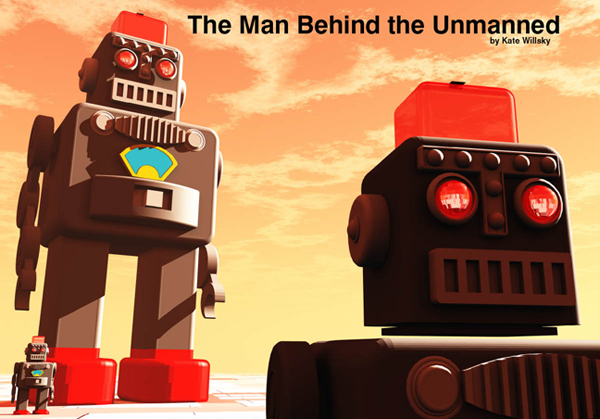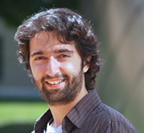

Robots, for all the impersonal connotations they call to mind, do not come from impersonal places. The inner workings of unmanned vehicles and automated human approximations result from the efforts of dynamic scholars and students, people with enough life and passion in them to give rise to a second sort of life form. Sertac Karaman, a Masters student at LIDS, is one of these people.
Two projects dominate Sertac’s hours on campus. The first, led by Professor Emilio Frazzoli, explores the potential for one human to control multiple robotic vehicles from a remote location. Ultimately, the project aspires to produce particularly tangible goals—unmanned air vehicles for the air force —but Sertac seems more interested in its theoretical roots. “It all originates from linguistics and philosophy,” he says, explaining that his work draws on natural languages that “look a lot like English” to control the robotic vehicles.Sertac’s second big project is a joint venture with LIDS and CSAIL. Here he works with a team lead by Professor Seth Teller to develop an autonomous forklift. Again, the end goal proves—just about literally—concrete, but the abstractions are what Sertac highlights first. “The project is a big conjunction of ideas,” drawing on topics ranging from linguistics to physics to digital imagining, he says. Eventually, the endeavor will produce a forklift that can be controlled by using a PDA, like a simple Nokia, which would allow the human controller to see the world through the robot’s eyes, so to speak, getting access to the sensory input it receives and using this information to plan the forklift’s trajectory. The project is, admittedly, ambitious, but, Sertac says, “I mean, when you see it working it’s really getting there.”
Sertac himself may have already gotten there. An interest in artificial intelligence (AI) during his childhood in Turkey—“In high school, I was making little robots, some little things that moved, that kind of thing”—led to building a small-scale robotic helicopter during his undergraduate studies, then to placing fourth in last year’s Darpa Urban Challenge—the CSAIL forklift project is a follow-up to the Darpa attempt, he says—and, eventually, to LIDS, where his converging interests in robotics and the theory behind it are readily indulged. “My interest in robotics and AI has been incremental,” he reflects. “Over the years, the projects have gotten bigger.”
In attributing the progress of his academic pursuits to the projects’ growth, rather than his own auspices, Sertac displays both a characteristic humility and an easygoing knack for letting his intellectual interests guide him, trusting that they will lead somewhere good. As a kid, he didn’t have aspirations to build unmanned air vehicles for the US Army; he just knew that he was interested in robotics, and wanted to keep learning more. When asked why he chose to study engineering, he laughs: “Actually, I’m not really sure. I guess I liked it.”
He liked it enough to leave his home country of Turkey—after graduating first in his class from Istanbul Technical University with a double major in computer science and mechanical engineering—to pursue a Masters degree in MIT’s Department of Mechanical Engineering. So why MIT? Another laugh: “It’s a good school,” he says. “It’s hard to reject once you get accepted.”
This take-it-as-it-comes attitude has served Sertac well. “I like it over here very much. I like MIT very much,” he says, “it was a really easy adjustment.” The international nature of MIT—“There seems to be someone from every continent in the world here”—certainly facilitated the adjustment, along with Boston’s welcoming nature. Having spent many of his pre-MIT years in a big city—Istanbul—Sertac thrives off the bustle of metropolitan activity. “I like going out in the city. I like restaurants. I like Italian cuisine, but that may be because of my advisor,” he laughs, referencing Professor Emilio Frazzoli of the Department of Aeronautics and Astronautics, who supervises Sertac’s work at LIDS. Always the engineer, Sertac touts Boston as “the optimal size city”—not so huge that it swallows a newcomer, but not small enough to create a dearth of things to do.
LIDS, Sertac says, approximates Boston’s friendly energy. “It’s like Boston—it’s not a big lab where nobody knows each other, but it’s also not a small lab where you can’t find people to collaborate with,” he says, citing the prevalence of talks and research opportunities and idea exchange as fundamental tenets of the LIDS environment. LIDS is also, fittingly for Sertac, theory-focused: “I think it’s the best environment at MIT for studying and learning control and decision theory.”
This setting will serve Sertac well as he works on his Masters thesis and then his PhD, which he hopes will focus on more abstract aspects of robotics and AI. The former, due this spring, will tie together his work with natural languages to command multiple unmanned vehicles. “The interesting thing,” he says laughingly, “is that I’ve been working on all these robotics projects, but I don’t think any of this is actually going to go into my thesis.”
Whatever the thesis does contain, however, will address the question of converting natural language to algorithms that allow for a mechanical entity to be controlled by a human with minimal—or no—knowledge of how the system works. “You state the commands in English, and this English has a conversion into a set of symbols that people call logic,” Sertac says, breaking it down into layman’s terms. “It’s like the logic you learn in high school, but an extension, a temporal extension that includes time in it.” The previously developed algorithm converts the natural language into a plan for the robots, taking into account the order in which tasks should be completed. “The algorithm parses it all out, and the person controlling it doesn’t need to know how many robots you have or how the algorithm works. The person controlling it just says a sentence,” Sertac explains. In other words, the controller gets a free ride, becoming a happy beneficiary of the efforts of Sertac and his colleagues.
This is not to say that it’s all work and no play for Sertac. He’s a regular at the MIT sailing pavilion—drawn particularly by midnight expeditions down the Charles under a full moon—and has played guitar since high school.
Stepping back to Sertac’s preferred realm of the theoretical, it seems appropriate to philosophize about how these leisure activities interface with robotics. Could a robot ever play guitar like a human? Sertac seems certain that one could, in fact he says that piano-playing robots already exist. “Maybe robots will become intelligent and do that,” he says, then pauses, “but there’s not much of a reason for a robot to play guitar. A robot could look at the notes and everything and play the piece, but when you play an instrument, the important thing is that you put something from you into the piece.”
True, the robot would pluck the correct notes and the guitar would produce the corresponding sounds—each part fulfilling its discrete function while remaining ignorant of the other, much like the automated forklift and its remote controller – but only a human can play a guitar or probe the limits of abstract theory in any meaningful way, and Sertac has set his sights to do just that.
